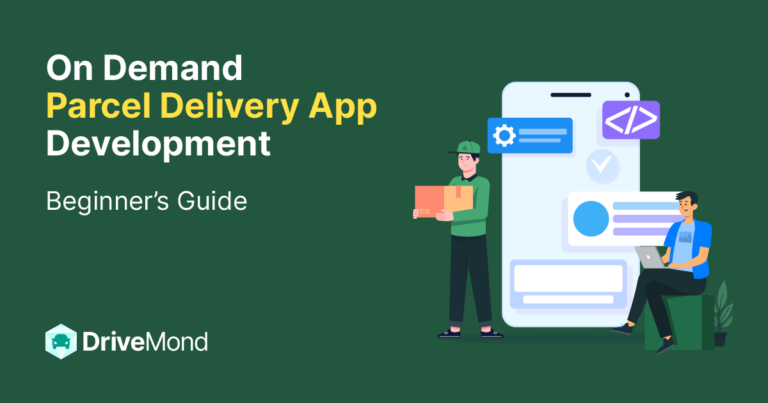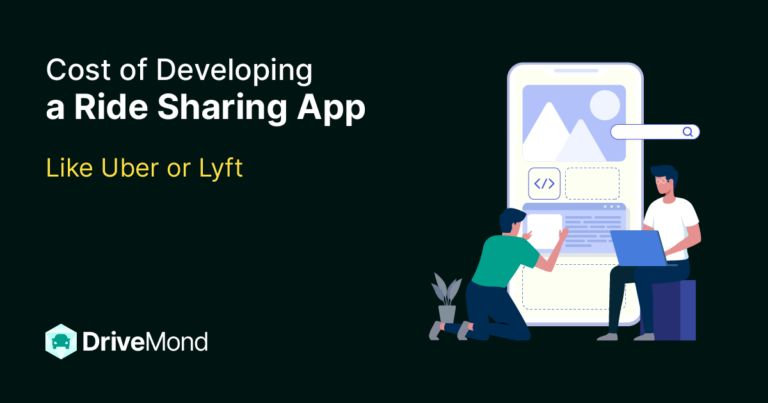The modern transportation has witnessed a significant shift with the rise of on demand ride sharing industry. And why wouldn’t it be? Think about how convenient, efficient, and cost-effective our life has become with this smart innovation.
Ride sharing businesses offer flexible transportation solutions via digital platforms. It’s quick, secure, and sustainable. According to Webinarcare, the ride sharing market value is projected to reach an estimated $220 billion by 2025. That’s less than a year from now!
Today, I’m going to share the ride sharing software and app development process from scratch. So, let’s cut to the chase.
How to develop a ride sharing app?
Being one of the successful ride sharing app developers in the industry, we know how it’s done. So, this step-by-step guide for how to develop a ride sharing app from scratch will help you initiate the required action.
Here’s how it works-
1. Pre-development phase
This is basically the ideation and planning phase, where you plan everything. It’s where you define your target market and potential customers. Key crucial things to consider in the pre-development phase are:
✔️Research & analysis
- Conduct thorough market research to understand the demand for ride-sharing services in your target area.
- Analyze competitors’ apps to identify their strengths, weaknesses, and unique features.
- Define your target audience, such as commuters, tourists, or students, and understand their needs and preferences.
✔️Define key features
After research and analysis, now you know what your target audience needs and what market gap there is that you can conquer with your ride sharing business. It’s time to define user-wise key features that your ride sharing app must have.
Here’s a set of key features I’ve added for your reference:
| Rider/User/Passenger | Driver | Admin |
| Login & signup | Login & signup | Business Management |
| Map navigation | Map navigation | Zone and fare |
| Find driver | Find rider | Driver management |
| Review and rating system | Driver profile | Promotion management |
| Multiple payment options | Loyalty & gamification | Trip management |
| Live chat and call | Automatic fare calculation | Transaction management |
| Rider profile | Live chat and call | User management |
| Trip History | Track rider location | 3rd party configurations |
| Wallet | Commission charge setup | |
| Loyalty Point |
Table: Key features of ride sharing app
✔️Choose tech stack
After listing down all the features, you need to choose the exact technology that you’re going to use to develop your ride sharing app. Here are some tech stacks that you can choose from-
- Platform compatibility: For platform compatibility in both iOS and Android, use React Native or Flutter frameworks.
- Backend: For the backend, use Laravel framework as it’s easy to use, edit, and customize. It’s a global framework that everyone can use. So you can find many supportive resources easily.
- Real-time data processing: To process data such as live tracking, route optimization and dynamic pricing in real-time, choose Node.js for backend development with WebSocket support. This allows real-time communication between server and client with seamless updates and notifications.
- Geolocation services: Ensure accurate geolocation services via Google Maps APIs or Mapbox SDK. These can give services like geocoding, routing, and live traffic updates.
- Security: Django or Laravel for backend development offer built-in security features like user authentication, CSRF protection, and SQL injection prevention against cyber threats
- Payment integration: Choose a 3rd party tech stack that supports seamless integration with payment gateways for secure and efficient processing of transactions such as Strip, Paytm, PayPal, SenangPay, SSLCommerz, etc.
- Data storage and management: Opt for databases and storage solutions that can handle large volumes of data efficiently and support data analytics for business insights. Such as PostgreSQL or MongoDB for structured and unstructured data storage, combined with AWS S3 or Google Cloud Storage for file storage and retrieval.
2. Development phase
After completing the pre-development phase, it’s time to move on to the second step of ride sharing app development, which is the development phase. This phase includes the following-
✔️Create wireframe, business logic, UI/UX
Start the development phase by creating wireframes to visualize the layout and ride sharing app flow. For this, you need to do the following-
- Focus on key screens such as user registration, ride booking, driver tracking, payment processing, and reviews/ratings.
- Use tools like Adobe XD, Sketch, or Figma to create wireframes that represent the app’s functionality and navigation flow.
- Determine the business logic for user registration, ride booking, driver allocation, payment processing, notifications, and customer support.
- Add branding elements and use color schemes and typography that align with the app’s branding guidelines.
✔️Start development
Now it’s time to start the development of your ride sharing app. Follow the following steps-
- Step 1: Set up the project environment
- Step 2: Integrate necessary tools and libraries
- Step 3: Develop the frontend and backed components. Focus on modular and reusable code.
- Step 4: Implement user authentication, ride booking, real-time location tracking, payment processing, and other features.
✔️Testing and deployment
After completing the development process, it’s time to test the app from tip to toe. In this phase, you need to conduct comprehensive testing to identify and fix bugs, ensure app functionality across different devices and screen sizes, and validate user experience. This phase also includes-
- Performance unit testing
- Integration and regression testing
- User acceptance testing
3. Post-development phase
Once testing is complete, deploy the ride-sharing app to app stores (Apple App Store, Google Play Store) or enterprise distribution platforms. Here’s a detailed post-development phase for a ride sharing app that includes launching your app and what you need to do after launch-
✔️Launch your app
Make a strategic plan to launch your ride sharing app and keep the key considerations in mind, such as target audience, geographic location, and competitors. After that, you need to:
- Submit the app to the Apple App Store and Google Play Store.
- Promote your app launch through social media, press releases, email newsletters, and other trending marketing channels.
✔️Branding and marketing
In this phase, you must develop a strong brand identity for your ride sharing business.
- Create a unique brand identity with logo design, color schemes, and brand message that resonate with your target market.
- Start marketing across various digital channels, including-
| Digital Marketing | Paid advertising, SEO, social media marketing, etc. |
| Content marketing | Blogging, guest posts, video contents, podcasts, etc. |
- Finally, you need to utilize marketing analytics and user feedback to refine your marketing strategies and optimize your user acquisition and retention tactics.
✔️Continuous improvement and maintenance
Now your ride sharing app has brand recognition and your target customers are onboarding day-by-day. Let’s establish a dedicated support team to help users with general inquiries, technical issues, and feedback. Here are some other ways that you can ensure continuous improvement and maintenance-
- Ensure regular app updates and maintenance releases
- Implement the latest operating systems and security patches
- Monitor app performance metrics, such as crash rates, app load times, and user engagement, to proactively identify and resolve any issues that may arise.
- Consider App Store and Play Store reviews for improvement.
Last but not least, stay informed about industry trends, technological advancements, and regulatory changes to adapt your app strategy and maintain a competitive edge in the market.
How to make money using ride sharing app?
As you’re developing your own branded ride sharing app from scratch, what’s the reason behind it? For making money, of course! In this blog section, I’ll describe various ways to make money using ride sharing apps.
Here are the top 5 ways to monetize your ride sharing app:
| Types of Monetization | Description |
| ✅ Commission on ride fees | Collect a commission from drivers for each ride they complete through the app. |
| ✅ Earn from idle fees | Allow riders/passengers to pause rides for emergencies and charge idle fees for using this feature. |
| ✅ Subscription model | Offer subscription packages to access premium features. For example, priority booking, advanced ride scheduling, etc. |
| ✅ Advertising | Display targeted ads to your ride sharing app users and generate revenue from advertisers. |
| ✅ Partnerships and sponsorships | Partner with local businesses, restaurants, or event venues and offer exclusive deals, discounts, or promos to the users. |
| ✅ Fremium model | Offer a basic version of the ride-sharing app for free, with limited features or functionality. Encourage users to upgrade to a premium version of the app through in-app purchases or subscription plans to unlock additional features and benefits. |
Table: Ride sharing app monetization types
Pros & Cons of Custom vs Readymade Ride Sharing Apps
There are two ways you can get your ride sharing app developed. One is, that you get to develop the entire app from scratch- with your own custom features and functionality. On the contrary, getting readymade ride sharing apps might limit you in the first place with fixed features and functionality. It can be launched as an MVP quicker than a custom app, you know.
So here we’re going to evaluate the pros and cons of both custom-built vs readymade ride sharing apps:
| Aspects | Custom Ride Sharing App Development | Readymade Ride Sharing Apps |
| Pros | ||
| Features & functionalities | Tailored to specific business requirements and objectives | Pre-built with standard features and functionalities |
| Unique brand identity | Allows to create unique brand identity | May lack uniqueness dute to standardized features |
| Full control | Businesses have full control over the development process | Dependency on the app solution provider for updates and maintenance |
| Cons | ||
| Development cost | Higher development cost starting from $10k to $100k | 90 times less expensive |
| Time need to launch | Needs longer time to launch due to customization | Quick launching possible with customization option |
| Development process | Extremely lengthy. May take 1 year to upto 5 years to develop from scratch | Almost zero time for development as it’s a pre-built solution |
| Expert team | Need to hire in-house tech team or outsource from software development company or expert freelancers for ride sharing development | No need to hire any team. Only ask for technical support from the app provider. |
| Support & maintenance | Self-managed support and maintenance | Provider-managed support and maintenance |
| Quality MVP for fundraising | Needs too much time to build MVP for fundraising | Ensures quality MVP for you to purchase and submit for fundraising |
Table: Pros and cons of custom developed an readymade ride sharing app
Expert Recommendation
The recommendation between custom-developed and readymade ride sharing apps depends on your specific business needs and resources. In such cases, readymade ride sharing apps like DriveMond is more suitable for businesses with limited technical resources, tight timelines, or straightforward feature requirements.
DriveMond is such a readymade solution that offers-
✅ Quick deployment
✅ Zero development cost
✅ Ready-to-launch MVP
✅ Ideal for startups who want to enter the market rapidly
That’s because, DriveMond comes with all the features I’ve discussed earlier but with an extended twist. Apart from the following features, you can always get customization services from the developer team whenever you need them.
Here are the features of DriveMond:
| Rider/User/Passenger | Driver | Admin |
| Login & signup | Login & signup | Business Management |
| Home page | Dashboard | Zone management |
| Map search page | Search for ride req. | Driver management |
| Find driver | Find rider | Parcel management |
| Offer custom fare | Bid for custom fare | Promotion management |
| Choose pickup location | Vehicle type | Trip management |
| Provide Review | Complete ride | Customer management |
| Parcel Delivery | Review | Employee management |
| Profile | Parcel delivery | Transaction management |
| Chatting System | Profile | User management |
| Trip History | Chatting system | 3rd party configurations |
| Wallet | Trip history | Commission charge setup |
| Loyalty Point | Wallet | |
| Help & Support | Loyalty Points |
Table: Userwise features of DriveMond ride sharing app
Not only this, it comes with flexible pricing options for entrepreneurs of all types starting from as low as $79. DriveMond is a fully documented ride sharing and parcel delivery system. The code is written in PHP using the Laravel and Flutter Framework with other trendy technology specifications. You’ll get extensive installation and customization services from their team along with technical support and assistance.
You can check out the DriveMond Demo from here if you want.
Wrapping up
The ride sharing industry is on rapid growth and you can be a part of this. For custom ride sharing app development, you can follow the previous steps I’ve discussed above. But if you want to launch your ride sharing app quickly at the lowest cost: choose DriveMond.
In this blog you’ve had the clear idea and pros & cons about the custom-built vs, readymade ride sharing apps as well. I hope you can make an informed decision soon enough.
See you in the next blog.
FAQs
What is a ride sharing app?
A ride sharing app is a convenient mobile tool that connects you with nearby drivers to share rides and get around town.
How do rideshare drivers make money?
The main way a ride share driver makes money is: Trip Payments.
How does the ride sharing app work?
The ride sharing app works in the following ways:
Step 1: Rider/passenger requests for a ride from the app
Step 2: Driver nearby gets the ride requests and accepts it
Step 3: After completing the ride, the rider/passenger pays the driver
Step 4: Both driver and rider can give ratings and reviews to each other
How to make ride sharing app more secure?
To make your ride sharing app more secure, use: driver verification, OTP authentication, emergency alert, real-time location tracking system, ReCaptcha, etc.









